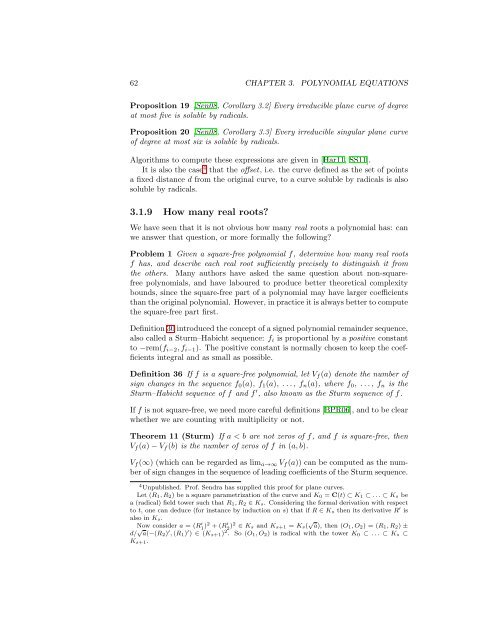Contents - Student subdomain for University of Bath
Contents - Student subdomain for University of Bath
Contents - Student subdomain for University of Bath
You also want an ePaper? Increase the reach of your titles
YUMPU automatically turns print PDFs into web optimized ePapers that Google loves.
62 CHAPTER 3. POLYNOMIAL EQUATIONS<br />
Proposition 19 [Sen08, Corollary 3.2] Every irreducible plane curve <strong>of</strong> degree<br />
at most five is soluble by radicals.<br />
Proposition 20 [Sen08, Corollary 3.3] Every irreducible singular plane curve<br />
<strong>of</strong> degree at most six is soluble by radicals.<br />
Algorithms to compute these expressions are given in [Har11, SS11].<br />
It is also the case 4 that the <strong>of</strong>fset, i.e. the curve defined as the set <strong>of</strong> points<br />
a fixed distance d from the original curve, to a curve soluble by radicals is also<br />
soluble by radicals.<br />
3.1.9 How many real roots?<br />
We have seen that it is not obvious how many real roots a polynomial has: can<br />
we answer that question, or more <strong>for</strong>mally the following?<br />
Problem 1 Given a square-free polynomial f, determine how many real roots<br />
f has, and describe each real root sufficiently precisely to distinguish it from<br />
the others. Many authors have asked the same question about non-squarefree<br />
polynomials, and have laboured to produce better theoretical complexity<br />
bounds, since the square-free part <strong>of</strong> a polynomial may have larger coefficients<br />
than the original polynomial. However, in practice it is always better to compute<br />
the square-free part first.<br />
Definition 30 introduced the concept <strong>of</strong> a signed polynomial remainder sequence,<br />
also called a Sturm–Habicht sequence: f i is proportional by a positive constant<br />
to −rem(f i−2 , f i−1 ). The positive constant is normally chosen to keep the coefficients<br />
integral and as small as possible.<br />
Definition 36 If f is a square-free polynomial, let V f (a) denote the number <strong>of</strong><br />
sign changes in the sequence f 0 (a), f 1 (a), . . . , f n (a), where f 0 , . . . , f n is the<br />
Sturm–Habicht sequence <strong>of</strong> f and f ′ , also known as the Sturm sequence <strong>of</strong> f.<br />
If f is not square-free, we need more careful definitions [BPR06], and to be clear<br />
whether we are counting with multiplicity or not.<br />
Theorem 11 (Sturm) If a < b are not zeros <strong>of</strong> f, and f is square-free, then<br />
V f (a) − V f (b) is the number <strong>of</strong> zeros <strong>of</strong> f in (a, b).<br />
V f (∞) (which can be regarded as lim a→∞ V f (a)) can be computed as the number<br />
<strong>of</strong> sign changes in the sequence <strong>of</strong> leading coefficients <strong>of</strong> the Sturm sequence.<br />
4 Unpublished. Pr<strong>of</strong>. Sendra has supplied this pro<strong>of</strong> <strong>for</strong> plane curves.<br />
Let (R 1 , R 2 ) be a square parametrization <strong>of</strong> the curve and K 0 = C(t) ⊂ K 1 ⊂ . . . ⊂ K s be<br />
a (radical) field tower such that R 1 , R 2 ∈ K s. Considering the <strong>for</strong>mal derivation with respect<br />
to t, one can deduce (<strong>for</strong> instance by induction on s) that if R ∈ K s then its derivative R ′ is<br />
also in K s.<br />
Now consider a = (R ′ 1 )2 + (R ′ 2 )2 ∈ K s and K s+1 = K s( √ a), then (O 1 , O 2 ) = (R 1 , R 2 ) ±<br />
d/ √ a(−(R 2 ) ′ , (R 1 ) ′ ) ∈ (K s+1 ) 2 . So (O 1 , O 2 ) is radical with the tower K 0 ⊂ . . . ⊂ K s ⊂<br />
K s+1 .












![[Luyben] Process Mod.. - Student subdomain for University of Bath](https://img.yumpu.com/26471077/1/171x260/luyben-process-mod-student-subdomain-for-university-of-bath.jpg?quality=85)



